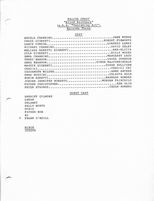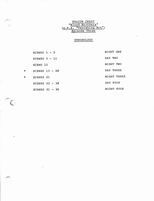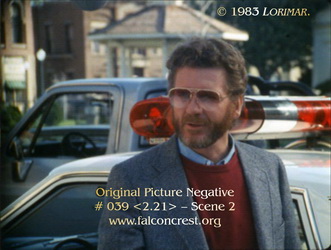





|
PRODUCING "FALCON CREST"
Revisions are usually made by the series creative forces, not necessarily the specific writer himself. Depending on the style of the executive producer's regime, there might be a notice on the cover or on the second page of the shooting script saying: "The producers acknowledge the need for creative input. However, no changes, additions, or deletions will be permitted unless authorized by the writing staff." In addition, copies of yellow covers might also contain a letter stating: "As you know, our scripts should be treated with the utmost confidentiality, especially those containing sensitive material with regard to the opening and closing sequences of each season. Please do not let your script out of your possession!" High-security pages, such as the ones revealing who was killed by Julia's gunshots in the season 2 cliffhanger, for example, are handed out on a "need-to-know" basis and may be stamped "For your eyes only!". It depends on the style of the executive producer's regime if actors know what will happen to their characters before they see their scripts. Some execs, like EARL HAMNER, prefer discussing the basics for character development with their actors in the early planning stage of a new season. Others, like JEFF FREILICH, like to decide all by themselves how to continue with the characters without consulting with the actors first. In that case, an actor or actress will often ask the producing staff for help in understanding their character's actions because a part can be quite difficult to play without knowing where a character is going or what he or she is thinking. The director or producer will then have to advise and guide the actor.
Filming the Wine Country Location Episodes Usually on July 1, filming for the new season begins. By that point of time, the scripts for the first six episodes have to be finished. Interior scenes for episodes 1 through 6 are shot on the sound stage at the studios in Los Angeles. Location filming in the Napa and Sonoma Valleys is done right after that — usually for 6 weeks in July and August. While the exteriors for episodes 1 through 6 are shot on location, the writers finish episodes 7 through 12. The exteriors for these episodes are filmed on location after the first 6-episode block. When the exterior work for episodes 7 through 12 is done, the cast and crew return to L.A. where the stage work for episodes 7 through 12 (interiors) is done. This is the usual process for the "Wine Country years" (up to season 7); season 2 was pretty much like the later years, but with 10 instead of 12 Wine Country location episodes. Two directors usually alternate on these episodes — either on all of them (seasons 2, 3, 4 and 7) or two directors taking turns on episode 1 through 6 and two others taking turns on episodes 7 through 12 (seasons 5 and 6). While in Northern California's Wine Country, cast and crew often work six days a week (Sundays are off); key crew members, however, might work an additional half day on Sunday if required by their work schedule. L.A. Filming The rest of each season — after the Wine Country location episodes — is filmed entirely at the studios or on location in and around Los Angeles, in most cases within the L.A. 30-Mile-Zone, the most popular area for location scouts to select filming sites that are situated conveniently nearby the major studios. Seasons 8 and 9 do not contain any new Wine Country location shots, but are entirely filmed in L.A. An episode traditionally takes seven "prep" days and 7 or, beginning with season 6, 6½ "shoot" days. Although the prep days actually involve only the director and production personnel, the script has to be finished before they begin. Directors are contracted on a show-by-show basis. Several directors have multiple deals in a season, but each episode is still assigned separately. At the production meeting before shooting, the director will run through each scene and explain to the heads of departments — props, costumes, sets, etc. — just how he envisions each scene. After the meeting, department heads will work up their budgets for the show. The executive producers and the head of the production estimating and budgeting department will then decide if the director's version matches budget criteria. An experienced director will ask only for things he knows can be covered in the budget. The average budget is about $ 1 million to 1.25 million an episode. As a show takes seven days to shoot, it can become difficult to tell when one show is over and another begins, especially because the scenes are not filmed in the same order as they are written and broadcast. Due to production requirements, such as the use of the same location for various scenes, for example, some scenes have to be shot in a row although many other scenes might be between them in the episode as it will be aired. Work usually begins with a 5:30 AM make-up call for some of the actors and actresses and a 7:00 or 7:30 AM call for crew. The first shot usually takes place around 7:30 or 8:00 AM as soon as the set is ready. Actors must always be ready and waiting. Since production time is money, actors stand by in their dressing rooms and are brought to the set about two minutes prior to the first walk-through. In addition to rehearsals, the actors will perform at least one walk-through for the camera. They will be already in make-up and wardrobe but draped with large, white, paper napkins at the throat to prevent make-up from ruining their clothes. Additional walk-throughs may be done for lighting or tricky camera shots. Each scene will be rehearsed once and then filmed, usually twice — unless the first take was astoundingly perfect or the shot is a complicated track shot with a moving camera. After the scene is done, it will be "covered" from several other angles; each angle will favor one of the speaking actors. In editing, the various versions will be cut together so the viewer sees the speaker and one or more reactions. In contrast to video taped shows, which usually use three cameras, shows shot on film, such as "Falcon Crest", rarely use more than one camera because the look and feel of the film is based upon the quality of the lighting. Two cameras may be used on an elaborate stunt, but otherwise the lighting will be adjusted to best flatter each situation and actor. Stage directions are at liberty of the director. Sometimes the script even suggests ad lib conversations or actions for certain characters in the background of a scene. Whereas the director might be allowed to make minor changes in the dialog during filming (depending on how much creative power the executive producer or other creative forces on his behalf usually delegate), the director will have to consult with the creative forces first in case he wants to make major changes during the shooting. On the set of "Falcon Crest", JANE WYMAN's scenes are usually scheduled first thing in the morning. JANIE is an early riser and usually is the first one to be in make-up. Out of respect for her age and professionalism, the producing staff wants to make her work schedule as comfortable as possible. So unless urgent production requirements tell otherwise, her scenes are the first ones to be filmed, and she can usually leave the set around noon.
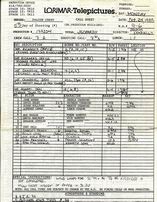 Of course, not every actor works every day and not every actor has scenes with all the other actors. The production office schedules the scenes for each day, the actors needed and the arrival times for makeup and on set. A call sheet is issued around 3:00 PM of the day prior to the shoot. It is a listing (usually written by the assistant director) of which actors will be required for which scenes and when they will be required. Of course, not every actor works every day and not every actor has scenes with all the other actors. The production office schedules the scenes for each day, the actors needed and the arrival times for makeup and on set. A call sheet is issued around 3:00 PM of the day prior to the shoot. It is a listing (usually written by the assistant director) of which actors will be required for which scenes and when they will be required.Actors must phone in for their "call". If they are not working the next day, the call sheet is marked with an "H" for "holding". All actors are paid on a per episode basis with salaries ranging from around $ 5,000 to over $ 100,000 an episode unless they are day players, who, since they only work one day, are paid only for that day. The shoot days of an episode, of course, are the prep days for the next episode. So different parts of the crew always work on different episodes. Post-Production The original picture negative (also called original camera negative) is the film in the motion picture camera capturing the original image. All other copies will be made from it. First, the original picture negative is processed by the film lab. Workprints are made for viewing "dailies", i.e. the shots of that day, and editing the picture on film. The director and the executive producers as well as sometimes a few other key crew members meet with the editors to view the "dailies" in the editing room (CBS-MTM viewing room 215 in seasons 5 through 7; projection room F in seasons 8 and 9) after the shooting has been finished. They decide which takes will be used, which scenes will be omitted in case there is too much film for the one-hour program and various other matters like that. One of the first steps in post-production after these decisions is the exact editing process. The editors have to make sure all necessary material as listed in the final shooting script and discussed in the viewing of the dailies is used for the final version. On the way there, sometimes several cuts are edited, depending on how often the creative forces want to check back on further omissions of scenes; the most common of these cuts is the director's cut; in case of "Falcon Crest", the "BROUGH cut" is not uncommon either — the cut made to accommodate the requests of LORIMAR Vice President – Creative Affairs JOANNE BROUGH, who also worked in various positions on the series during its whole run. The final aim in editing is that the episode does not exceed the one-hour program (including commercials). Usually, the original picture negative is now used in the editing process to create the episode. A negative cutter conforms the negative by cutting the original picture negative and any opticals and cementing it together into several rolls of film. The edited original negative is then copied to create a safety positive, which can be used as a backup to create a usable negative. At this point, an answer print (sometimes also referred to as "the master") will be created from the original picture negative for the producing staff's discussions, and upon its approval, interpositives and internegatives are created, from which the release prints are made. In general, the original picture negative is considered too important and delicate to be used for any processes more than necessary, as each pass through a lab process carries the risk of further degrading the quality of the negative by scratching the emulsion. Once an answer print is approved, the interpositives and internegatives are regarded as the earliest generation of the finished and graded film, and are almost always used for transfers to video and DVD or new film restorations. The original picture negative is usually regarded as a last resort in the event that all of the intermediate elements have been compromised or lost. The visible frame in the final cut of the show is smaller than the actual picture negative. "Falcon Crest" is filmed on a 35 mm film with an aspect ratio of the camera negative of 1.37 : 1 while the final product has a 1.33 : 1 (= 4 : 3) aspect ratio on the TV screen. Visible parts on the outer areas of the original picture negative are lost in the distribution copies because the picture is cropped in the editing process. The following pictures illustrate the full format of the original picture negative vs. the smaller format ending up in the distribution prints for TV (and also the DVD masters). The example is from scene 2 of # 039 <2.21>.
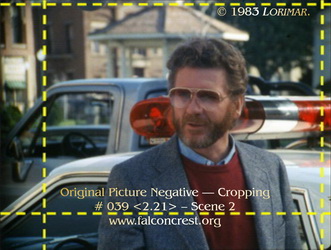 The auxiliary lines are a visualization of how the picture is cropped during the editing process for the distribution copies. The format indicated by the auxiliary lines matches the usual TV aspect ratio from the show's era, 1.33 : 1 (= 4 : 3). This illustrates how much of the original picture is lost and could be regained in case of a film restoration from the original picture negative. The auxiliary lines are a visualization of how the picture is cropped during the editing process for the distribution copies. The format indicated by the auxiliary lines matches the usual TV aspect ratio from the show's era, 1.33 : 1 (= 4 : 3). This illustrates how much of the original picture is lost and could be regained in case of a film restoration from the original picture negative.The position of the auxiliary lines in this sample matches the following screen grab from the NTSC distribution copy used particularly in North America.
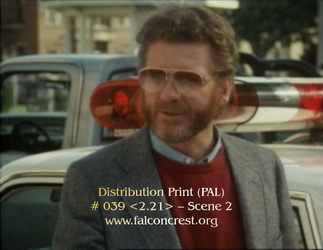 This screen capture is from the final PAL distribution copy (particularly Europe, Australia and South America). The picture quality in this later-generation print is even significantly lower than the NTSC print because the PAL master is usually created from the NTSC master. This screen capture is from the final PAL distribution copy (particularly Europe, Australia and South America). The picture quality in this later-generation print is even significantly lower than the NTSC print because the PAL master is usually created from the NTSC master.This frame also illustrates that creating the masters for the different TV formats, NTSC and PAL, sometimes leads to slightly different results in the visible frame. The PAL copy of this episode apparently shows more of the original picture on the lower frame while the upper frame was cropped in contrast to the NTSC distribution copy. This is a result of how the negative was positioned in the film transfer. The associate / coordinating producer (VICTORIA LaFORTUNE), the music editor and the score composer — as well as maybe other creative forces (at their own discretion) — meet upon completion of the editing for a spotting session to view the final cut and select where to put in background music, which the composer assigned to the episode then has to compose, conduct and orchestrate within a few days so it can be added to the final cut. The editing of the episode as well as all the sound work and all other steps in post-production — including telecine transfers from film to video, either to NTSC TV format (mainly North America and some other parts of the world) or PAL (mainly Europe and Australia, for instance) — are done while the next episode goes into its shoot days. After approximately three to four weeks altogether, one episode has been finished, including having been viewed by the executive producers and other key members of the producing staff as well as CBS executives. Airing The episode will finally be aired not earlier than one week after being completed. |

